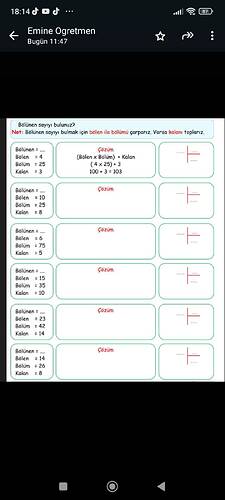How to find the dividend using the divisor, quotient, and remainder?
Answer:
To find the dividend in a division problem, you can use the formula:
[
\text{Dividend} = (\text{Divisor} \times \text{Quotient}) + \text{Remainder}
]
This formula derives from the basic division equation:
[
\text{Dividend} = (\text{Divisor} \times \text{Quotient}) + \text{Remainder}
]
Now, let’s apply this formula to solve the problems given in the image.
Step 1: Solving the Examples
-
First Problem:
- Divisor: 4
- Quotient: 25
- Remainder: 3
Using the formula:
[
\text{Dividend} = (4 \times 25) + 3 = 100 + 3 = 103
] -
Second Problem:
- Divisor: 10
- Quotient: 25
- Remainder: 8
Using the formula:
[
\text{Dividend} = (10 \times 25) + 8 = 250 + 8 = 258
] -
Third Problem:
- Divisor: 6
- Quotient: 75
- Remainder: 5
Using the formula:
[
\text{Dividend} = (6 \times 75) + 5 = 450 + 5 = 455
] -
Fourth Problem:
- Divisor: 15
- Quotient: 35
- Remainder: 10
Using the formula:
[
\text{Dividend} = (15 \times 35) + 10 = 525 + 10 = 535
] -
Fifth Problem:
- Divisor: 23
- Quotient: 42
- Remainder: 14
Using the formula:
[
\text{Dividend} = (23 \times 42) + 14 = 966 + 14 = 980
] -
Sixth Problem:
- Divisor: 14
- Quotient: 26
- Remainder: 8
Using the formula:
[
\text{Dividend} = (14 \times 26) + 8 = 364 + 8 = 372
]
Final Answer:
The dividends for each problem are:
- 103
- 258
- 455
- 535
- 980
- 372
Feel free to use this formula to find dividends in other similar problems!
